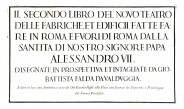
The Trinità dei Monti hill before the construction of the Spanish Steps
During the 1500s and 1600s, the French church of Trinità dei Monti was connected with Piazza di Spagna below by steep paths that ran up a tree-lined slope. In the late 1600s, it became apparent that a staircase was needed to link the church and the square. However, the work was not tackled until the papacy of Clement XI, who commissioned designs from a number of illustrious artists of the day, including Alessandro Specchi and Francesco De Sanctis, the architect who worked for the Ordine dei Minimi (which owned the land). De Sanctis, whose works included the new façade for the Church of Trinità dei Pellegrini, was chosen by Clement XI’s successor, Innocent XII, who gave the go-ahead in 1723 in the hope that work would be completed in time for the 1725 Jubilee. The staircase was indeed inaugurated during the Holy Year, despite the fact that work had not entirely been completed. The final phase of remodelling the hill on which Trinità dei Monti sits was the erection of the Sallustian obelisk in front of the convent, which Pius VI commissioned in the late 1780s, as clearly shown in Giovanni Battista Cipriani’s engraving.
Giovanni Battista Falda, Chiesa della Santiss. Trinità de Monti de PP. minimi francesi sul monte Pincio,in: Id., Il nuovo teatro delle fabriche et edificii in prospettiva di Roma moderna..., vol. II (Il secondo libro del novo teatro delle fabriche, et edificii, fatte fare in Roma, e fuori di Roma dalla santità di nostro signore papa Alessandro VII), Roma 1665-1667